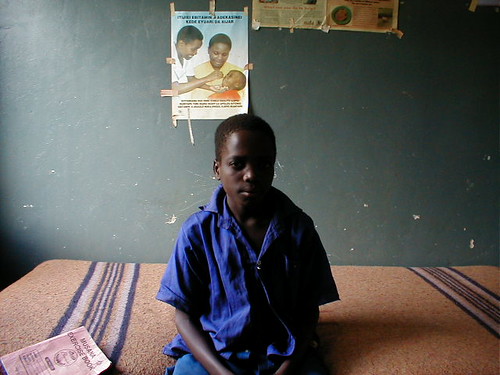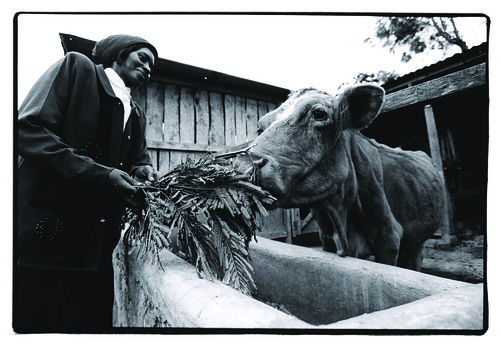A child with sleeping sickness undergoes lengthy recovery treatment at a sleeping sickness clinic in Soroti, Uganda (photo credit: ILRI).
John McDermott, a Canadian deputy director general for research at the International Livestock Research Institute (ILRI) and a veterinary epidemiologist by training, and Delia Grace, an Irish veterinary epidemiologist working in food safety and many other areas of livestock health, have written a new policy brief on agriculture-associated diseases.
This policy brief has recently been disseminated by McDermott and Grace at an international conference on the agriculture, nutrition and health interface in New Delhi and a conference on the ‘One Health’ approach to tackling human and animal health, held in Melbourne.
McDermott and Grace argue that the way we approach agriculture does not serve human interests as a whole. ‘In the past, agricultural research and development largely focused on improving the production, productivity and profitability of agricultural enterprises. The nutritional and other benefits of agriculture were not always optimized, while the negative impacts on health, well-being and the environment were often ignored. This was especially problematic for livestock systems, with especially complex negative and positive impacts on human health and well-being.’
They give as an example a side effect of agricultural intensification: disease. ‘Highly pathogenic avian influenza (HPAI) is a notorious example of a disease that was fostered by intensified agricultural production and spread through lengthened poultry value chains and the global movement of people and animals. Large-scale irrigation projects, designed to increase agriculture productivity, have created ecosystems conducive to schistosomiasis and Rift Valley fever.’
And the reason we fail to foresee the negative effects of some agricultural practices, they say, is because the responses to disease threats are often compartmentalized. ‘Instead of analysing the tradeoffs between agricultural benefits and risks, the agriculture sector focuses on productivity, while the health sector focuses on managing disease. A careful look at the epidemiology of diseases associated with agriculture, and past experience of control efforts, shows that successful management must be systems-based rather than sectorally designed.’
‘At least 61% of all human pathogens are zoonotic (transmissible between animals and people),’ they write, ‘and zoonoses make up 75% of emerging infectious diseases. A new disease emerges every four months; many are trivial, but HIV, SARS, and avian influenza illustrate the huge potential impacts. Zoonoses and zoonotic diseases recently emerged from animals are responsible for 7% of the total disease burden in least-developed countries.
‘As well as sickening and killing billions of people each year, these diseases damage economies, societies and environments. While there is no metric that captures the full cost of disease, assessments of specific disease outbreaks suggest the scale of potential impacts. . . .
‘. . . There are two broad scenarios that characterize poor countries. At one extreme are neglected areas that lack even the most basic services; in these “cold spots,” diseases persist that are controlled elsewhere, with strong links to poverty, malnutrition and powerlessness. At the other extreme are areas of rapid intensification, where new and often unexpected disease threats emerge in response to rapidly changing practices and interactions between people, animals and ecosystems. These areas are hot spots for the emergence of new diseases (of which 75% are zoonotic). They also are more vulnerable to food-borne disease, as agricultural supply chains diversify and outpace workable regulatory mechanisms.
‘. . . What cannot be measured cannot be effectively and efficiently managed. Addressing agriculture-associated disease requires assessing and prioritizing its impacts, by measuring not only the multiple burdens of disease but also the multiple costs and benefits of potential interventions—across health, agriculture and other sectors. . . .
‘But these assessment tools and results have rarely been integrated to yield a comprehensive assessment of the health, economic and environmental costs of a particular disease. . . .
‘The complexities of agriculture-associated diseases call for more integrated and comprehensive approaches to analyse and address them, as envisioned in One Health and Eco- Health perspectives . . . . These integrated approaches offer a broad framework for understanding and addressing complex disease: they bring together key elements of human, animal and ecosystem health; and they explicitly address the social, economic and political determinants of health. Both of these global approaches recognize agriculture- and ecosystem-based interventions as a key component of multi-disciplinary approaches for managing diseases. For example, food-borne disease requires management throughout the field-to-fork risk pathway. Zoonoses in particular cannot be controlled, in most cases, while disease remains in the animal reservoir. Similarly, agriculture practices that create health risks require farm-level intervention.
‘Systemic One Health and EcoHealth approaches require development and testing of methods, tools and approaches to better support management of the diseases associated with agriculture. The potential impacts justify the substantial investment required. . . .
‘As a basis for framing sound policies, information is needed on the multiple (that is, cross-sectoral) burdens of disease and the multiple costs and benefits of control, as well as the sustainability, feasibility and acceptability of control options. An example of cross-disciplinary research that effectively influenced policy is the case of smallholder dairy in Kenya. In the light of research by ILRI and partners, assessing both public health risks and poverty impacts of regulation, the health regulations requiring pasteurization of milk were reversed; the economic benefits of the change were later estimated at USD26 million per year. This positive change required new collaboration between research, government and non-governmental organizations and the private sector, as well as new ways of working . . . .
‘Many agriculture-associated diseases are characterized by complexity, uncertainty and high-potential impact. They call for both analytic thinking, to break problems into manageable components that can be tackled over time, and holistic thinking, to recognize patterns and wider implications as well as potential benefits.
‘The analytic approach is illustrated in the new decision-support tool developed to address Rift Valley fever in Kenya. In savannah areas of East Africa, climate events trigger a cascade of changes in environment and vectors, causing outbreaks of Rift Valley fever among livestock and (ultimately) humans. Improving information on step-wise events can lead to better decisions about whether, when, where and how to institute control . . . .
‘An example of holistic thinking is pattern recognition applied to disease dynamics, recognizing that emerging diseases have multiple drivers. A synoptic view of apparently unrelated health threats—the unexpected establishment of chikungunya fever in northern Italy, the sudden appearance of West Nile virus in North America, the increasing frequency of Rift Valley fever epidemics in the Arabian Peninsula, and the emergence of bluetongue virus in northern Europe—strengthens the suspicion that a warming climate is driving disease expansion generally.
‘Complex problems often benefit from a synergy of various areas of expertise and approaches. . . . Complex problems also require a longer term view, informed by the understanding that short-term solutions can have unintended effects that lead to long-term problems—as in the case of agricultural intensification fostering health threats. . . .
‘New, integrative ways of working on complex problems, such as One Health and EcoHealth, require new institutional arrangements. The agriculture, environment and health sectors are not designed to promote integrated, multi-disciplinary approaches to complex, cross-sectoral problems. But many exciting initiatives provide examples of successful institutional collaboration. . . .
‘Agriculture and health are intimately linked. Many diseases have agricultural roots—food-borne diseases, water-associated diseases, many zoonoses, most emerging infectious diseases, and occupational diseases associated with agrifood chains. These diseases create an especially heavy burden for poor countries, with far-reaching impacts. This brief views agriculture-associated disease as the dimension of public health shaped by the interaction between humans, animals and agro- ecoystems. This conceptual approach presents new opportunities for shaping agriculture to improve health outcomes, in both the short and long terms.
‘Understanding the multiple burdens of disease is a first step in its rational management. As agriculture-associated diseases occur at the interface of human health, animal health, agriculture and ecosystems, addressing them often requires systems-based thinking and multi-disciplinary approaches. These approaches, in turn, require new ways of working and institutional arrangements. Several promising initiatives demonstrate convincing benefits of new ways of working across disciplines, despite the considerable barriers to cooperation.’
Read the whole ILRI policy brief by John McDermott and Delia Grace: Agriculture-associated diseases: Adapting agriculture to improve human health, February 2011.






.jpg)


